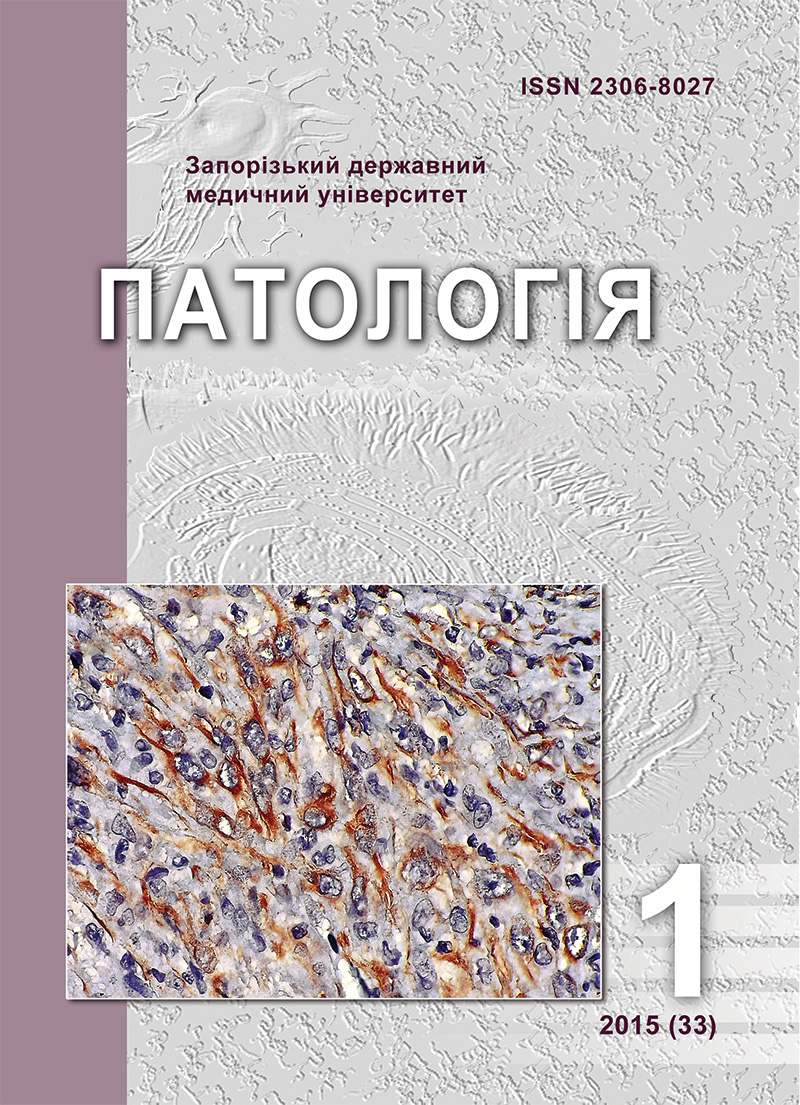Distribution of FoxP3+regulatoryT-cells in rat’spancreatic lymph nodes under streptozotocin-induced diabetes and metformin administration
DOI:
https://doi.org/10.14739/2310-1237.2015.1.42830Keywords:
Diabetes mellitus, FoxP3, Metformin, TregAbstract
Type 1 diabetes mellitus is a T-cellmediated autoimmune disease characterized by the destruction of β-cells of the pancreas. Numerous studies have demonstrated the key role of FoxP3+ regulatory T-cells in the development of type 1 diabetes.
The aim of our study:1) to determine the expression patterns of transcription factor FoxP3 in the pancreatic lymph node cells in animal model of diabetes mellitus and 2) to assay an effect of metformin on these processes.
Methods and results.The studywas conducted on 60 male Wistar rats with streptozotocin-induced modeling diabetes with various duration of the diabetes. Within development of type 1 diabetes mellitus the number of Treg pancreatic lymph nodes has been reduced.
Conclusion.These findings demonstrate the ability of metformin to increase the number of Treg.
References
Araki, K., Ellebedy, A., & Ahmed, R. (2011). mTOR in the immune system.CurrOpinCellBiol, 23(6), 707–715.
Calderon, B., &Unanue, E. (2012). Antigen presentation events in autoimmune diabetes.CurrOpinImmunol, 24(1), 119–128. doi: 10.1016/j.coi.2011.11.005.
Ferraro, A., Socci, C., Stabilini, A., Valle, A., Monti, P., Piemonti, L., et al. (2011). Expansion of Th17 cells and functional defects in T regulatory cells are key features of the pancreatic lymph nodes in patients with type 1 diabetes. Diabetes, 60, 2903–2913.doi: 10.2337/db11-0090.
Ferraro, A., Socci, C., & Battaglia, M. (2011). Expansion of Th17 Cells and Functional Defects in T Regulatory Cells Are Key Features of the Pancreatic Lymph Nodes in Patients With Type 1 Diabetes. Diabetes, 60(11), 2903–2913. doi: 10.2337/db11-0090.
Gagnerault, M., Luan, J., Lotton, C., &Lepault, F. (2002). Pancreatic lymph nodes are required for priming of β cell reactive T cells in NOD mice. J Exp Med., 196, 369–377.doi: 10.1084/jem.20011353.
Gerriets, V., &Rathmell, J. (2012). Metabolic pathways in T cell fate and function. Trends Immunol., 33(4), 168–73. doi: 10.1016/j.it.2012.01.010.
Green, E., Choi, Y., &Flavell, R. (2002). Pancreatic lymph node-derived CD4(+)CD25(+) Treg cells: highly potent regulators of diabetes that require TRANCE-RANK signals. Immunity, 16, 183–191. doi:10.1016/S1074-7613(02)00279-0.
Gardie, D. (2011). AMP-activated protein kinase: an energy sensor that regulates all aspects of cell function. Genes Dev., 25, 1895–908.doi: 10.1101/gad.17420111.
Kole, T., Zheng, Y., Zarek. P., Matthews, K., Xiao, B., Worley, P., et al. (2009). The mTOR kinase differentially regulates effector and regulatory T cell lineage commitment. Immunity,30, 832–844. doi: 10.1016/j.immuni.2009.04.014.
Levisetti, M., Suri, A., Frederick, K., &Unanue, E. (2004). Absence of lymph nodes in NOD mice treated with lymphotoxin-β receptor immunoglobulin protects from diabetes. Diabetes, 53, 3115–3119. doi:10.2337/diabetes.53.12.3115.
MacIver, N., Michalek, R., &Rathmell, J. (2013). Metabolic regulation of T lymphocytes.Annu Rev Immunol, 31, 259–83.doi: 10.1146/annurev-immunol-032712-095956.
Michalek, R., Gerriets, V., Jacobs, S., Macintyre, A., MacIver, N., Mason, E., et al. (2011). Cutting edge: distinct glycolytic and lipid oxidative metabolic programs are essential for effector and regulatory CD4+ T cell subsets. J Immunol, 186, 3299–303.doi: 10.4049/jimmunol.1003613.
Nasri, H., & Rafieian-Kopaei, M. (2014). Metformin: Current knowledge. J Res Med Sci, 19(7), 658–664.
Nti, B., Markman, J., Bertera, S., Styche, A., Lakomy, R., Subbotin, V. et al. (2012). Treg cells in pancreatic lymph nodes: the possible role in diabetogenesis and beta cell regeneration in a T1D model. Cell MolImmunol, 9, 455–463. doi: 10.1038/cmi.2012.36.
Salmond, R., &Zamoyska, R. (2011). The influence of mTOR on T helper cell differentiation and dendritic cell function. Eur J Immunol,41(8), 2137–2141. doi: 10.1002/eji.201141523.
Tan, T., Xiang, Y., Chang, C., & Zhou, Z. (2014). Alteration of regulatory T cells in type 1 diabetes mellitus: a comprehensive review.Clin. Rev. Allergy Immunol., 47(2), 234–243. doi: 10.1007/s12016-014-8440-0.
Tonkin, D., & Haskins, K. (2009). Regulatory Tcells enter the pancreas during suppression of type 1 diabetes and inhibit effector Tcells and macrophages in a TGF-beta-dependent manner.Eur J Immunol, 39, 1313–1322.doi: 10.1002/eji.200838916.
Willcox,A., Richardson, S., Bone, A., Foulis, A., & Morgan, N. (2009) Analysis of islet inflammation in human type 1 diabetes.ClinExpImmunol, 155,173–181.doi: 10.1111/j.1365-2249.2008.03860.x.
Yaochite, J., Caliari-Oliveira, C., & Davanso, M. (2013). Dynamic changes of the Th17/Tc17 and regulatory T cell populations interfere in the experimental autoimmune diabetes pathogenesis.Immunobiology, 218(3), 338–52.doi: 10.1016/j.imbio.2012.05.010.
Zdravkovic, N., Shahin, A., Arsenijevic, N., Lukic, M., &Mensah-Brown, E. (2009). Regulatory T cells and ST2 signaling control diabetes induction with multiple low doses of streptozotocin.MolImmunol, 47(1), 28–36. doi: 10.1016/j.molimm.2008.12.023.
Downloads
How to Cite
Issue
Section
License
Authors who publish with this journal agree to the following terms:
Authors retain copyright and grant the journal right of first publication with the work simultaneously licensed under a Creative Commons Attribution License that allows others to share the work with an acknowledgement of the work's authorship and initial publication in this journal.

Authors are able to enter into separate, additional contractual arrangements for the non-exclusive distribution of the journal's published version of the work (e.g., post it to an institutional repository or publish it in a book), with an acknowledgement of its initial publication in this journal.
Authors are permitted and encouraged to post their work online (e.g., in institutional repositories or on their website) prior to and during the submission process, as it can lead to productive exchanges, as well as earlier and greater citation of published work (SeeThe Effect of Open Access).

